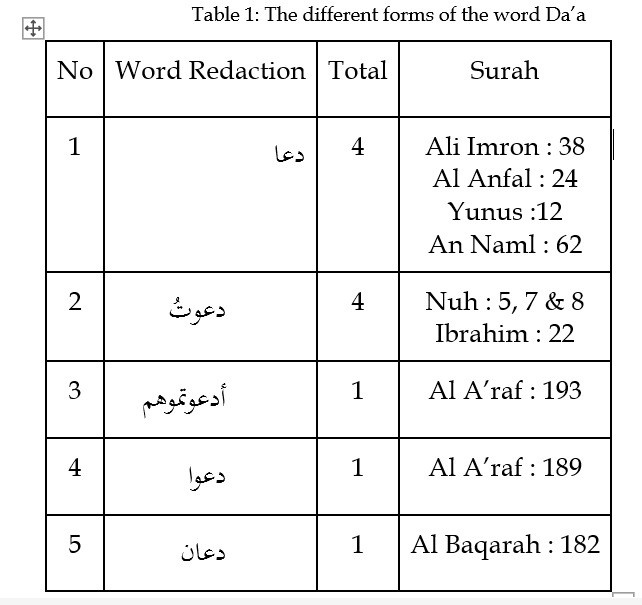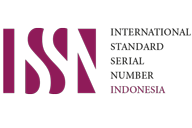Analysis of the Meaning of Da'aa in the Interpretation of Ibn Kathir and As-Sa'di with the Approach of Wujuh wa al-Nadhoir and Toshihiko Izutsu's Semantics
DOI:
https://doi.org/10.69526/bir.v1i3.176Keywords:
da'a, Tafseer, semanticAbstract
This study aims to examine the interpretation of da'wah verses in the Qur'an that contain the word “دعا” (pray, call, call out). The word “دعا” has a broad meaning in the Qur'an, including the call to pray to Allah as a form of worship and obedience. Using the approaches of comparative tafsir, wujuh wan nadhoir, and toshihiko izutsu semantics, this study identifies and analyzes relevant verses, as well as tracing the interpretations of classical and contemporary scholars regarding the use of the word “دعا”. The results show that the word “دعا” not only describes supplication and hope to Allah, but also includes deep spiritual aspects in the context of da'wah. Prayer in these verses serves as a means of communication with Allah, confirmation of faith, and as a call for good and a warning against evil. This study highlights the importance of understanding the meaning of supplication in da'wah to increase the effectiveness of the message conveyed and strengthen the spiritual connection with Allah. This study also shows that the interpretation of da'wah verses that use the word “دعا” provides comprehensive guidance for Muslims to be more solemn in every prayer.
References
A. Nurhartanto, “Metode Penafsiran Kontekstual Al-Qur’an Dalam Perspektif Ushul Fiqih: Kajian Terhadap Ayat-Ayat Keadilan,” J. Pedagog., vol. 16, no. 2, pp. 93–102, 2023.
A. Nurhartanto, “Shalat dan Pengaruhnya Dalam Membentuk Akhlakul Karimah (Suatu Tinjauan Kependidikan),” J. Pedagog., vol. 11, no. 1, pp. 47–59, 2018.
A. Nurhartanto, “Ushul Fiqih Dan Fungsinya Dalm Kajian Hukum Islam,” J. Pedagog., vol. 14, no. 1, pp. 39–51, 2021.
A. Nurhartanto, “Upaya Meningkatkan Nilai-Nilai Moderasi Beragama Di STAI Muhammadiyah Blora Melalui Penguatan Pemahaman Kaidah Kaidah Ushul Fiqih,” J. Pedagog., vol. 15, no. 2, pp. 88–101, 2022.
A. Nurhartanto, “Metode Penafsiran Dalam Ushul Fiqih Kontemporer: Kajian Terhadap Pendekatan Literal Dan Kontekstual,” J. Pedagog., vol. 16, no. 1, pp. 55–66, 2023.
R. Murtyaningsih, “Manajemen Strategi Dalam Meningkatkan Mutu Pendidikan Di Program Studi Pendidikan Agama Islam STAIM Blora,” J. Pedagog., vol. 15, no. 2, pp. 51–66, 2022.
T. Setyo, R. Murtyaningsih, and S. A. Setiawan, “RECONSTRUCTION OF ISLAMIC EDUCATION GOALS IN THE MODERN ERA PERSPECTIVES OF WESTERN CLASSICAL PHILOSOPHERS AND MUSLIM PHILOSOPHERS,” J. Pedagog., vol. 17, no. 2, pp. 199–208, 2024.
Y. Utami, R. Murtyaningsih, E. Susilowati, and M. D. Prastiawan, “Edukasi Berbasis Komunitas: Membangun Kesadaran Orang Tua dan Remaja tentang Dampak Pernikahan Dini di Desa Ketileng Kecamatan Todanan Kabupaten Blora,” J. Pengabdi. Kpd. Masy., vol. 4, no. 3, pp. 196–206, 2024.
R. Murtyaningsih, “Implementasi Manajemen Pendidikan Dalam Mengembangkan Lembaga Pendidikan Islam,” J. Pedagog., vol. 16, no. 1, pp. 171–183, 2023.
R. Murtyaningsih, “Implementasi Metode Pembelajaran Everyone is a Teacher Here untuk Meningkatkan Prestasi Belajar Pendidikan Agama Islam di SMK Muhammadiyah 2 Blora,” J. Pedagog., vol. 10, no. 3, pp. 140–159, 2017.
R. Murtyaningsih, “Manajemen Sumber Daya Manusia Dalam Praktik Peningkatan Mutu Pendidikan Di STAI Muhammadiyah Blora,” J. Pedagog., vol. 15, no. 1, pp. 52–74, 2022.
I. Katsir, Tafsir Al-Qur’anul ’Adzim. Beirut: Daarul Jiil, 1991.
R. Murtyaningsih and Y. Utami, “Supervisi Pendidikan: Langkah Strategis dalam Meningkatkan Mutu Pembelajaran,” J. Alwatzikhoebillah Kaji. Islam. Pendidikan, Ekon. Hum., vol. 10, no. 2, pp. 536–545, 2024.
Abdurrahman bin Nashir As-Sa’diy, Taysir al-Karim ar Rahman fi Tafsir Kalam al- Mannan. Beirut: Muassasah Ar Risalah, 2002.
R. Murtyaningsih, “Peranan Guru dalam Memotivasi Belajar Siswa,” J. Pedagog., vol. 12, no. 1, pp. 38–48, 2019.
R. Murtyaningsih, “Analisis Penerapan Sistem Manajemen Pendidikan Tinggi Dalam Mewujudkan Good University Governance Di STAI Muhammadiyah Blora,” J. Pedagog., vol. 17, no. 1, pp. 55–72, 2024.
R. Murtyaningsih, “Kontribusi Etos Kerja Islami Terhadap Kinerja Dosen,” J. Pedagog., vol. 14, no. 1, pp. 139–156, 2021.
I. A. Zaripov, “UNAMBIGUITY OF POLYSEMY: ON THE DEFINITION OF THE QUR’ANIC DISCIPLINE AL-WUJŪH WA-N-NAẒĀ’IR,” Vost., vol. 2023, no. 6, pp. 160–170, 2023, doi: https://doi.org/10.31857/S086919080022342-3.
T. Izutsu, God and Man in the Qur’an: Semantic of the Qur’anic Weltanschauung. Tokyo: Keio University, 1964.
I. El-Zeiny, “The Semantics and Ethics of Sa‘ādah (Happiness) in the Qur’ān,” Islam. Stud., vol. 59, no. 1, pp. 95–113, 2020.
S. K. Al-Khawaldeh, M. M. Al-Ajaleen, N. N. Al-Khawaldeh, M. M. A. Kayed, and M. M. Alkayid, “The Semantic and Contextual Meanings of the Cognitive Words ‘yʕqilu:n, yatafakaru:n, yatadabaru:n, yafqahu:n’ in Holy Qur’an,” Theory Pract. Lang. Stud., vol. 14, no. 6, pp. 1838–1849, 2024, doi: https://doi.org/10.17507/tpls.1406.25.
Y. Y. Mirza, Tafsīr Ibn Kathīr: A Window Onto Medieval Islam and a Guide to the Development of Modern Islamic Orthodoxy. 2021. doi: https://doi.org/10.4324/9781315885360-26.
G. Mediamer and Adiwijaya, “Semantic Feature Analysis for Multi-Label Text Classification on Topics of the Al-Quran Verses,” J. Inf. Process. Syst., vol. 20, no. 1, pp. 1–12, 2024, doi: https://doi.org/10.3745/JIPS.02.0209.
S. Chukhanov and N. Kairbekov, “The importance of a semantic approach in understanding the texts of the Holy Quran and Sunnah,” Pharos J. Theol., vol. 105, no. 3, 2024, doi: https://doi.org/10.46222/pharosjot.105.36.
M. A. Çalgan, “Ibn Kathir’s hadith commentary method and text criticism in tafseer Al-Quran Al-azeem | Tefsîrü’l-Kurâni’l-azîm’de I˙bn Kesîr’in Hadis Şerh Metodu ve Metin Tenkidi,” Cumhur. Dent. J., vol. 24, no. 1, pp. 97–118, 2020, doi: https://doi.org/10.18505/cuid.674002.
A. Dehqan, K. R. Barandaq, and K. Parvini, “The Semantics of ‘šaʕara’ (to realize) As a Quranic Word and Its Status in the Semantic Field of Cognition,” Lang. Relat. Res., vol. 14, no. 6, pp. 305–336, 2024, doi: https://doi.org/10.29252/LRR.14.4.10.
A. G. Siddiek, “Viewpoints in the translation of the holy QURAN,” Int. J. Appl. Linguist. English Lit., vol. 1, no. 2, pp. 18–25, 2012, doi: https://doi.org/10.7575/ijalel.v.1n.2p.18.

Downloads
Published
Issue
Section
License
Copyright (c) 2023 Muhammad Fatih Kanzul Akrom, Mahfud Mahmudi, Muhammad Fatkhur Rasyid, Abdullah Yusuf Mushthofa, Fayiz Yan Avicena (Author)

This work is licensed under a Creative Commons Attribution 4.0 International License.



















